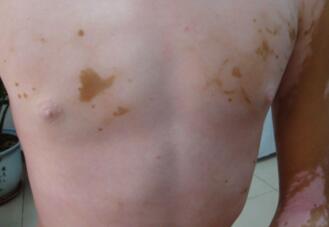Vitiligo Symptoms for Patients
 In the world, man and woman both can get this disease. The morbidity is different in different regions and for different races. Generally speaking, if human skin color is deep, the patients will be more. For example, in America, the morbidity is about 1%. In India, the morbidity is about 4%. In our country, the morbidity is about 0.1%~2%. For different genders, there is no obvious differences. And all age groups can get vitiligo. The main groups are teenagers. The vitiligo onset age is around 20 years old, which occupied half of the vitiligo patients. Every positions on human body can get vitiligo, and the skin lesions are local depigmentation. The color is usually milk white, and it can also be pink white. The appearance is smooth without rash. White spots boundary is clear. Edge pigment increases compared to normal skin. The hair is normal or white in the white spots. Vitiligo usually appears at sunlight positions and friction damage positions, such as face, leg, neck, arm, the back of hands, waist and etc. The lesions is usually symmetrical, and white spots are along with nerve segment and distributing banding shape. Lip, labia, glans penis, and prepuce medial mucosa also involve vitiligo. White spots can relapse after sunlight. In winter, there are depigmentation in the center or edge of white spots. About 20% patients are sensitive to ultraviolet ray. In sunlight, white spots can develop rapidly. Mechanical stimulation, such as acupuncture, scratch, skin pressure and other local stimulation, such as burn, infection, cold injury, irradiation can make normal skin get white spots. Or make original white spots enlarge, even spread to the whole body. White spots quantities are not sure. It can not decrease or disappear. Most white spots will increase, enlarge, and adjacent white spots can emerge into irregular pieces, even spread to the wile body.
In the world, man and woman both can get this disease. The morbidity is different in different regions and for different races. Generally speaking, if human skin color is deep, the patients will be more. For example, in America, the morbidity is about 1%. In India, the morbidity is about 4%. In our country, the morbidity is about 0.1%~2%. For different genders, there is no obvious differences. And all age groups can get vitiligo. The main groups are teenagers. The vitiligo onset age is around 20 years old, which occupied half of the vitiligo patients. Every positions on human body can get vitiligo, and the skin lesions are local depigmentation. The color is usually milk white, and it can also be pink white. The appearance is smooth without rash. White spots boundary is clear. Edge pigment increases compared to normal skin. The hair is normal or white in the white spots. Vitiligo usually appears at sunlight positions and friction damage positions, such as face, leg, neck, arm, the back of hands, waist and etc. The lesions is usually symmetrical, and white spots are along with nerve segment and distributing banding shape. Lip, labia, glans penis, and prepuce medial mucosa also involve vitiligo. White spots can relapse after sunlight. In winter, there are depigmentation in the center or edge of white spots. About 20% patients are sensitive to ultraviolet ray. In sunlight, white spots can develop rapidly. Mechanical stimulation, such as acupuncture, scratch, skin pressure and other local stimulation, such as burn, infection, cold injury, irradiation can make normal skin get white spots. Or make original white spots enlarge, even spread to the whole body. White spots quantities are not sure. It can not decrease or disappear. Most white spots will increase, enlarge, and adjacent white spots can emerge into irregular pieces, even spread to the wile body.
Vitiligo has no subjective symptom, few patients accompany with local inch feeling, and some patients accompany with autoimmune diseases, such as diabetes, thyroid, adrenal gland function insufficiency, pernicious anemia, rheumatic arthritis, scleroderma, atopic dermatitis and etc.
According to white spots shape, positions, scale, and treatment reaction, vitiligo can be divided to four types in clinic:
First, local type: vitiligo is usually on one positions.
Second, sporadic type: vitiligo is distributing at some positions, the size is not the same and is usually symmetrical.
Third, generalized type: it is developed by the above two types, the lesion positions are beyond half of human body.
Forth, segmental type: according to depigmentation condition, it can be divided to be complete type and incomplete type.



Leave a Comment